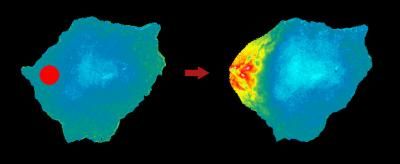Faster and more efficient thanks to "defects"
Three-dimensional photonic crystals will revolutionize telecommunications
Smaller, faster, more efficient: BASF research scientists are helping to revolutionize the future world of telecommunications - with the aid of three-dimensional photonic crystals. In a three-year project, BASF is researching into the development of these crystals together with partners such as Hanover Laser Center, Thales Aerospace Division, Photon Design Ltd., the Technical University of Denmark and the Ecole Nationale Supérieure des Télécommunications de Bretagne. By the end of 2008, the partners in the "NewTon" project expect to have developed the first functional components of this new technology. The long-term goal is to use three-dimensional photonic crystals as construction elements in telecommunication. Half of the project is being funded by the European Union.
Many times more information can be transmitted by light in the same time as has so far been possible with electricity. This is why telephone conversations, websites, photographs or music, for example, are now increasingly being transmitted in optical fibers. At present, however, this technology still has one drawback at the "network nodes". Indeed, at these nodes the routing of the information to the end-user is still done electrically, because no competitive, compact all-optical routing processor is yet available. This costs time and energy.
This is where the research activities of BASF and its partners come into the picture. They are developing a photonic crystal capable of reflecting only single colors of the white light depending on the observation angle. This phenomenon is known from nature: the splendid, shimmering colors on butterfly wings derive from the properties of photonic crystals.
"A structured three-dimensional photonic crystal could be the key component for a compact optical semiconductor or even for an all-optical routing processor", is the opinion of Dr. Reinhold J. Leyrer who is BASF's project leader in Polymer Research division. "Converting optical signals into electrical signals would then be superfluous". But the scientists first have to develop a stable, structured three-dimensional photonic crystal. And exactly this is the goal of the EU project "NewTon". This kind of basic research projects are especially suited to activate the European scientific competence, in order to strengthen the competitiveness of the whole region and of all involved industrial branches.
Most read news
Other news from the department science

Get the analytics and lab tech industry in your inbox
By submitting this form you agree that LUMITOS AG will send you the newsletter(s) selected above by email. Your data will not be passed on to third parties. Your data will be stored and processed in accordance with our data protection regulations. LUMITOS may contact you by email for the purpose of advertising or market and opinion surveys. You can revoke your consent at any time without giving reasons to LUMITOS AG, Ernst-Augustin-Str. 2, 12489 Berlin, Germany or by e-mail at revoke@lumitos.com with effect for the future. In addition, each email contains a link to unsubscribe from the corresponding newsletter.





















































